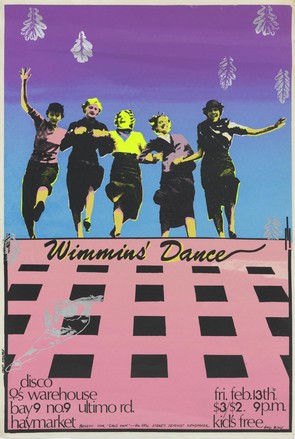Wimmins' Dance, Benefit for Girls' Own, the New Sydney Feminist Newspaper
Silkscreen print on paper, Wimmins’ Warehouse Screen-printers
PXD 673/26
Purchased 1994
The Wimmins’ Warehouse Screen-printers created posters showing women as mothers, workers, writers and friends. The warehouse was run as a women’s collective from 1979 to 1981 in a five-storey warehouse in Sydney’s Haymarket area. An unofficial headquarters for the social and cultural activity of the Women’s Liberation Movement, the warehouse applied the values of feminism, equality and collectivism to all creative output which extended throughout the ensuing decades into a broad range of women’s activities. This was especially true of the Wimmins’ Warehouse Screen-printers and Girls’ Own newspaper collectives, which produced artworks and published articles without creators’ names.
The Women's (Wimmins) Warehouse
The Women’s (Wimmins)
Warehouse was established as a women’s collective in 1979. It provided a
short-lived and unofficial headquarters for the social and cultural activity of
the Women’s Liberation Movement (WLM) in Sydney, Australia. The building itself was a five-storey warehouse at 9 Ultimo Road in Sydney’s Haymarket area, that was further divided into a mixture
of office and workshop spaces, as well as a cafe.
One of the aims of the Warehouse project was to encourage
women to establish various enterprises. Regular workshops were held where women
could learn a range of skills, including traditionally male skills such as
carpentry. Dances were also held to pay the rent, often featuring a drop-in
band of women who had learned to play instruments in the collective’s music
co-op. The Warehouse closed in 1981 but some of the projects it spawned
continued long after. The group Stray
Dags, for example, had some commercial success, while Harridan Screen
printers (1981-88) and the Tin Sheds were two enterprises that emerged from the
Wimmins Warehouse screen printing collective.
Women's posters tell a
story of women speaking up and out about health, child care, lesbianism,
violence, nuclear disarmament, the women's movement and the arts. Spurred on by
the anti-war movement, the rise of feminism and the election of the Whitlam
government in 1972, collectives and community-based groups worked to produced
social and political statements in poster form. Women enjoyed the
non-hierarchical arrangement of collectives and taught themselves to
screen-print – often with little or no art training. Poster makers grabbed the
idea of making art enjoyable and accessible to everyone, creating art for the
streets that would reach a wide audience, to be sold cheaply and/or distributed
through unconventional channels such as feminist bookshops.
Jan Fieldsend taught the screen-printing technique
at the Wimmins Warehouse to anyone who was interested. These posters are
ephemeral; they peel and tear off and become fragile with time. Changes in
printing technology have also led to the demise of the hand screen-printed
poster as a vehicle for political expression.



 Back to list
Back to list